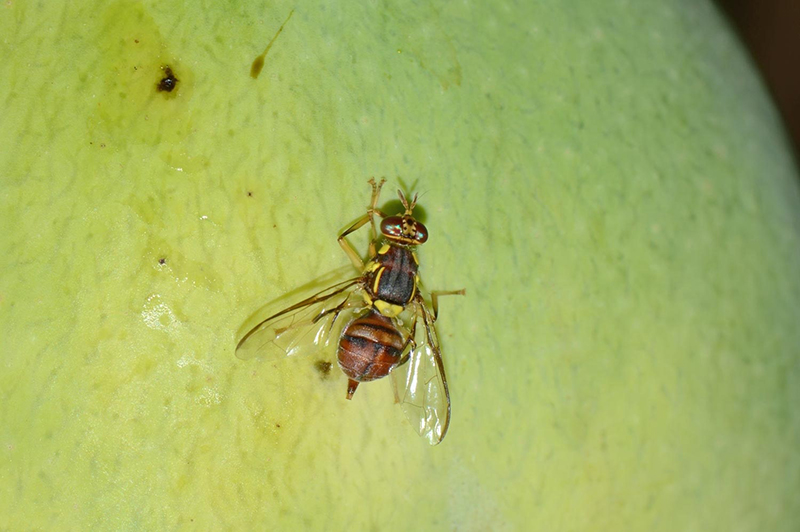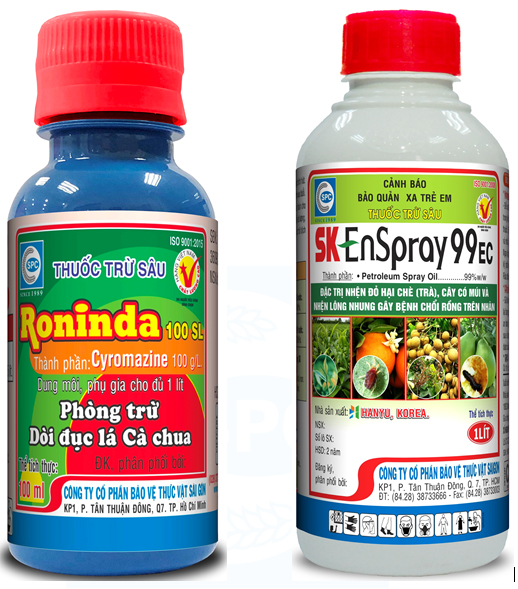|
Oriental Fruit Fly
23/10/2021
MSc Huynh Kim Ngoc The Oriental fruit fly, scientifically known as Bactrocera dorsalis (Hendel), belongs to the family Trypetidae, order Diptera. The fruit fly is a polyphagous insect that damages more than 30 types of fruit and vegetable crops. There are many species of fruit flies, the most common of which are B. dorsalis, B.coresta, B.cucurbitea. Damages: The fruit fly is an important pest in temperate, subtropical and tropical regions. In many mango growing areas in Vietnam, flies cause serious damage. Flies prefer to lay eggs on ripe fruit, but also on green fruit. The fruit skin where it is bored by flies is black, soft, and oozing with sap that attracts insects and fungi to lay eggs, causing damage to the fruit, causing discoloration and rot. Fruit infested with flies may drop before ripening or remain anchored on the tree. If the fruit is still on the tree, the commercial value is also reduced because the pulp of the fruit is rotten. Flies not only reduce yield and quality, but also prevent mangoes from being exported because flies are the leading subject of quarantine in many countries around the world. Biological properties: Flies (adults) are about 6-9 mm long, with a wingspan of about 8-12 mm, yellow-brown in color with black stripes on the abdomen. Female flies are larger than male ones and have long, pointed egg-laying needles at the end of their abdomens. Flies after hatching 3-4 days will pair and lay eggs. Female flies prefer to lay eggs on ripe fruit. One can lay 150- 400 eggs. When laying, the fly uses an egg-laying needle to prick the left skin at the junction between the skin and the fruit pulp and lays eggs in clusters. The average length of the eggs is 1.0 - 1.5 mm, the ends are pointed, slightly curved, the newly laid eggs are white, turn yellow and hatch after 1-3 days. Newly hatched larvae (maggots) are pale yellow, bore to the fruit pulp, the larger the larvae, the deeper they penetrate inside, making the fruit damaged, rotten, and oozing out water. The larval stage occurs inside the fruit, lasts about 8-10 days, through 2 molts (3 years old) before shrinking and snapping out of the fruit to pupate in the soil. The pupal stage occurs in the soil layer about 1 - 5 cm deep, lasts 7 - 10 days, then after being pupated , larvae turn adults fly out of the ground and continue a new cycle. The life cycle of male flies is about 20-30 days. Treatment: • Harvest early when the fruit is just ripe to avoid harmful flies and infection. • Do not intercrop guava, papaya, citrus, longan... in the mango orchard. • Fruit covering: When the mango is about the size of a chicken egg, it should cover the fruit it should cover the fruit, in addition to preventing fruit flies, the fruit bag also helps prevent anthracnose, bottom rot, seed borer, etc. Although fruit covering takes time and effort, but save costs and make the fruit skin more beautiful and attractive. • Herbal medicine: Use holy basil / basil and smash it into pieces , hang on the tree to attract flies, then spray insecticide. • Field sanitation: Collect and destroy (burn or bury) mango fruit that falls to the ground as well as remains on the tree after harvest because that is where flies live. • Lure traps: Use ripe bananas, oranges, pineapples... mixed with pesticides (SecSaigon 5, 10EC, Sherzol EC) to attract and kill flies. Set 30-100 traps / 1 hectare of garden. • Chemical spraying: Can spray Roninda 100SL or spray SK Enspray 99EC mineral oil (0.2%). It is recommended to spray twice during the fruiting period, note the isolation time printed on the label |
To prevent, in addition to plowing and burying weed seeds, collecting weed stalks and stumps left after tilling the land to burn, not letting weeds produce seeds in production fields, etc., the use of chemical products is still a measure. optimal because of its ability to thoroughly kill weeds, reduce labor and take advantage of more time than manual weeding.
Miner has the scientific name Phyllocnistis citrella Staint., family Phyllocnistidae, order Lepidoptera. The miner occurs in many countries in the tropics and subtropics. The main host of the miner is the citrus family - Rutaceae. In addition, the miner also attacks mangosteen and some other plants.
Adult is a small planthopper, with a body 2-3 mm long, the whole body is ash gray, slightly greenish, the wings are opaque with many small brown spots.Eggs are oval, 0.3 mm long, have a pointed end and are attached directly to the leaf surface, leaf axils.
Green bugs specialize in the fruit of citrus groups (oranges, tangerines, lemons, grapefruits, kumquats...), some people call them orange bugs, or orange suckers. Their scientific name is Rhynchocoris poseidon or Rhynchocoris humeralis.
In Vietnam, yellow leaf curl disease is very common on papaya trees, especially the disease is often severe in areas of high and continuous planting, areas with hot and arid climates. The disease has significantly reduced the yield and quality of papaya. Gardens that are infected early when the plants are young may not yield. However, up to now, many gardeners still do not know the cause and how to fix it.
Spider mites are common pests on citrus trees, especially in hot and dry climates that are suitable for spiders to grow and cause severe damage.The group of harmful spiders is usually very small in size, unlike the natural enemy spiders.
This group includes species that are generally very small in size, causing damage by sucking plant sap (on leaves, fruits, branches, stems).
There are many species of mealybugs present on the group of Oranges,Tangerines,Grapefruits and Lemons (Citrus), which can be divided into 2 groups:
+ Group of sticky mealybugs with common varieties such as Lepidosaphes, Aonidiella, Coccus and Saissetia.
+ Group of flower mealybugs with common genera and species such as Pseudococcus, Planococcus and Icerya purchasi.
Dry branches and berries disease often appear to be common damage on coffee gardens during the rainy season. The disease causes death of branchs, dry fruit, severely affects the canopy structure and coffee yield if not paid attention to prevention.
Pink disease commonly causes diseases on rubber plantations in the rainy season, especially on garden from 4-8 years old. This year, rubber has to go through a period of severe drought, weakening the tree, so now in tnshe rainy season it is easy to get infected. Therefore, it is necessary to pay attention to good management to avoid affecting the garden.
In recent years, the area of citrus has been expanded because it is a fruit tree with high economic efficiency. However, in order to sell at a high price, not only in quality but consumers also require the external beauty of the fruit, so pest management on citrus is a matter of great concern to farmers. The hot season is a favorable condition for thrips to develop and cause damage, affecting the commercial value of fruit.
- Headquarters
- SAIGON PLANT PROTECTION JOINT STOCK COMPANY
- RQ 1, Nguyen Van Quy St., Tan Thuan Ward, HCM City
- Tax code: 0300632232
- Tel: (028) 38 733 295 - 38 732 077
- Fax: (028) 38 733 003 - 38 733 391
- Website: www.spchcmc.vn - Email: info@spchcmc.vn
- SAIGON PLANT PROTECTION COMPANY
- SAIGON PLANT PROTECTION JOINT STOCK ENTERPRISE
- Lot C1-C3 Hiep Phuoc Industrial Park, Hiep Phuoc Commune, HCM City
- Tel: (028) 3873 4089 - Fax: (028) 3873 4086
- Affiliated Unit
-
- Quick Links
- Home
- About us
- Career Opportunities













